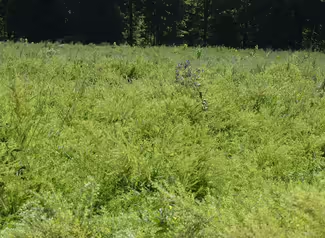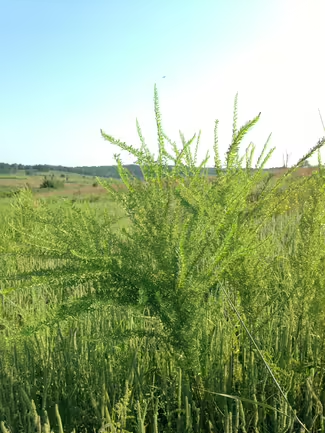
Invasive Sericea Lespedeza
Sericea Lespedeza Damage
Sericea lespedeza (Lespedeza cuneata), also known as Chinese Bush Clover, is an invasive nitrogen-fixing legume that produces many seeds that remain viable in the soil for more than two decades. It is also allelopathic, releasing compounds into the soil that harm other plants. It establishes in disturbed areas and crowds out native plant species.
History of Sericea Lespedeza
Sericea lespedeza was introduced from Asia in the 1800s, originally to the southeast U.S. Land managers planted it for erosion control, forage, and reclamation of degraded land. It has since spread north and west. Sericea is very difficult to control. The plant is not palatable to grazers when it is mature due to high tannin content and it also responds positively to fire.
Regulation of Sericea Lespedeza
Sericea lespedeza is not regulated as an invasive species or a noxious weed in Illinois. It is regulated by many other states.

Sericea is an herbaceous legume, but late in the season, its stems become woody. It can grow up to 4-feet tall. It is usually single-stemmed but is often densely branched. It is densely covered in trifoliate leaves with slender leaflets. It produces flowers along the branches. The flowers are white with a purple spot, and pea-shaped. The flowers produce brown seeds with a seed covering. The seeds can remain viable in the soil for more than 20 years. Sericea also produces self-fertilizing flowers that do not have petals and remain closed.

- Mechanical removal: Repeated mowing before it flowers can prevent seed production, but will not eradicate the plant.
- Fire: only recommended for use alongside herbicide application. Burning can cause a flush of new growth from the seedbank. These seedlings can then be treated with herbicide.
- Chemical control: Apply 0.4% triclopyr + fluroxypyr while plants are actively growing. 2% v/v of triclopyr can provide some control but is not as effective as the triclopyr/fluroxypyr mix. Applications during flower bud formation are most effective. Always read and follow the herbicide label before initiating treatment.
Invasive species, including Lespedeza cuneata, threaten the success of grassland restoration through their ability to alter species composition following invasion. Through exploring the mechanisms by which an invasive functions (above- and below-ground) and the response of native plants...


